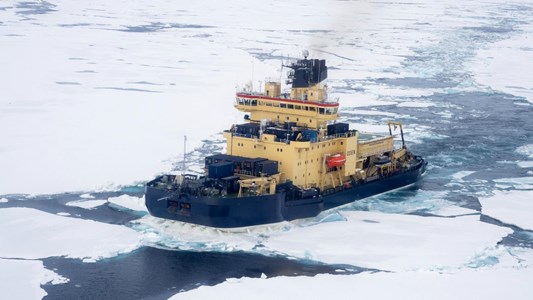It is especially important to measure the consequences when excessive amounts of moisture rapidly move into the Arctic, as they are becoming more common, in the Arctic that is warming four times faster than the rest of the planet.
An international expedition will set off on the Swedish icebreaker Oden on 7 May 2023 from Svalbard into the High Arctic studying the ArtofMelt (Atmospheric Rivers and the onset of sea ice Melt). The researchers examine how the atmosphere, sea ice and ocean interact (ASOI), especially during Atmospheric River (AR) events.
AR events can trigger massive ice melt as the high winds and waves cause the ice to fracture leading to in part rapid evaporation, and the formation of clouds that can carry rain and snow out of the Arctic – where is that moisture headed and what are it’s distinct fingerprints these spring-generated storms move into Europe, Eurasia and over Greenland. With the collaboration of numerous research teams, the spring processes will be comprehensively measured in an orchestrated manner including: atmospheric processes, the isotope geochemistry of air and the seawater as well as the amount water vapor and trace gas fluxes (CO2 and CH4) into the atmosphere and an entire suite of ocean chemistry and water mass attributes.
A research team from the Universities of Oulu and Alaska lead by UArctic Research Chair, Professor Jeff Welker, join the crew of 40 international researchers within the Swedish Polar Research Secretariat's ArtofMelt 2023 expedition. The expedition is headed into the Fram Strait between Svalbard and north-east Greenland and points north to capture ASOI prior to the injections of warm AR events, during these periods and following the events. The researchers return to Svalbard 15 June.
The icebreaker Oden is one of the world's elite icebreakers and has some of the most advanced research platforms in the polar seas. A helicopter will be on board, and the expedition will include quick departures in search of atmospheric rivers detected by satellites.
Welker and colleagues from the Finnish Meteorological Institute, have received funding from the Finnish Ministry of Foreign Affairs to lead a study of the Arctic’s water cycle and ASOI at the seasonal transition between winter and summer, during sea ice melt.

Photo: Polarforskningssekretariatet
Onboard the icebreaker Oden, Welker and his research engineer, Valtteri Hyöky, will carry out an entire suite of continuous, high frequency (each second) measurements on atmospheric water vapor from the ship’s mast and sea water isotope values, simultaneously. These water vapor and sea water measurements will be coupled to evaporation rates, wind directions, humidity, sea ice coverage, sea water salinity and sea water temperatures.
The water vapor and sea water isotope measurements are key to tracing the subarctic sources of atmospheric river water vapor, and the processes associated with moisture transport into, within and out of the Arctic. Coupling the water vapor measurements with those of sea water will allow Welker’s team to delineate how sea water masses and currents may change during these atmospheric river events and are coupled to changes in sea ice conditions, cloud formations and the energy balance of the Arctic Ocean.
Welker's team is investigating how isotopes in water vapour over the ocean and in seawater record new conditions as sea ice breaks up and rapid and massive evaporation occurs as the ocean becomes ice-free. In addition, Welker and his team will be among the first to document the vertical and horizontal water vapor isotope profiles within a 10 km radius of the Oden icebreaker and extending vertically up to over 1000 m using the HELiPod. The HELiPod package is an instrumented unit that is suspended below the helicopter during flights in the vicinity of the ship.
Additional members of Welker’s team are postdoctoral researchers Hannah Bailey and Ben Kopec, University of Oulu and Dr. Eric Klein, University of Alaska Anchorage.
Read more:
ArtofMelt 2023 expedition
How isotopes can be used to trace the origin of a storm?
